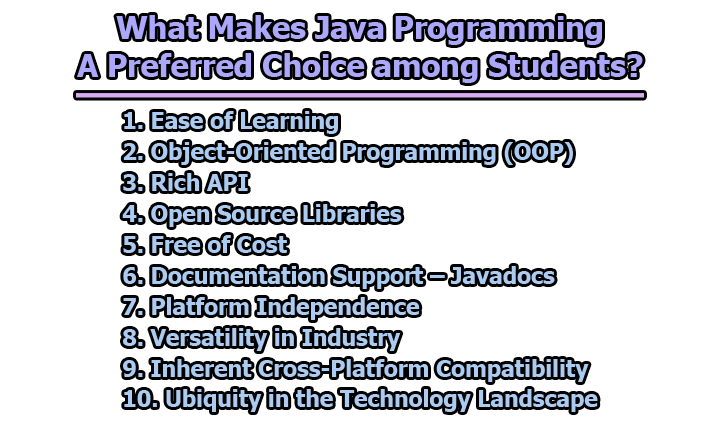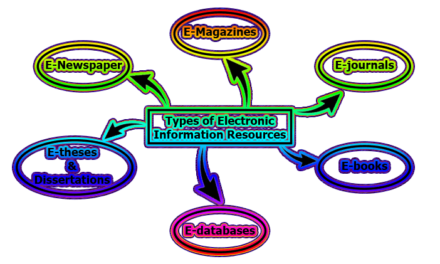What Makes Java Programming a Preferred Choice among Students?
Java programming has emerged as a preferred choice among students for several compelling reasons, making it a cornerstone in the realm of computer science education. Its widespread adoption can be attributed to a combination of factors that cater to the needs and preferences of students entering the programming landscape. In this discussion, we justify the question, “What Makes Java Programming a Preferred Choice among Students?”
1. Ease of Learning: Java’s appeal to students begins with its user-friendly design and straightforward syntax. The language was intentionally developed to be accessible, making it an ideal choice for beginners. The syntax is clean and structured, resembling plain English, which helps students focus on learning programming concepts without being overwhelmed by intricate language intricacies. This ease of learning encourages students to quickly build their coding skills and gain confidence in their ability to write Java programs.
2. Object-Oriented Programming (OOP): Java’s commitment to Object-Oriented Programming (OOP) principles provides students with a solid foundation in modern software development practices. OOP encourages code organization based on real-world entities, fostering modularity and reusability. As students become adept at thinking in terms of objects and classes, they acquire essential skills applicable to a wide range of programming scenarios. Java’s strong support for OOP ensures that students develop a robust understanding of fundamental programming concepts.
3. Rich API: Java’s extensive set of Application Programming Interfaces (APIs) is a key factor in its popularity among students. APIs provide pre-built functionalities that students can readily incorporate into their programs, saving time and effort in coding complex features from scratch. This not only accelerates the development process but also exposes students to industry-standard practices, giving them a head start in creating efficient and functional applications.
4. Open Source Libraries: Java’s vibrant ecosystem is enriched by a vast collection of open-source libraries. These libraries cover a wide array of functionalities, from data manipulation to user interface development. For students, this means access to a treasure trove of resources that they can explore, learn from, and contribute to. The availability of open-source libraries fosters a collaborative learning environment, where students can leverage existing solutions, customize them, and share their innovations with the community.
5. Free of Cost: Java’s open-source nature ensures that students can freely access the Java Development Kit (JDK) without incurring any expenses. This cost-effectiveness eliminates financial barriers for students who might be constrained by tight budgets. The ability to download and use Java without any licensing fees encourages a broad and diverse group of students to explore and master the language, democratizing access to a powerful programming tool.
6. Documentation Support – Javadocs: Java’s commitment to comprehensive documentation, including Javadocs, significantly aids students in their learning journey. Javadocs provide detailed information about classes, methods, and their usage. This meticulous documentation helps students understand the purpose and functionality of various components within the Java language. It serves as an invaluable reference guide, allowing students to navigate the language efficiently and fostering good coding practices.
7. Platform Independence: Java’s hallmark feature, “Write Once, Run Anywhere” (WORA), is made possible by the Java Virtual Machine (JVM). This allows Java programs to be executed on any device with a compatible JVM, irrespective of the underlying operating system. For students, this means they can develop applications without worrying about platform-specific nuances, providing a seamless experience when deploying their creations across different devices and environments.
8. Versatility in Industry: Java’s versatility is evident in its widespread use across various industries. It powers web development, mobile applications (Android apps), enterprise solutions, and more. Students choosing Java position themselves to explore a wide range of career opportunities. The skills acquired while learning Java are transferable, making students well-prepared for the diverse demands of the ever-evolving tech industry.
9. Inherent Cross-Platform Compatibility: Java’s inherent ability to run on different platforms ensures that students can create applications that are compatible with various operating systems. This cross-platform compatibility simplifies the deployment process, allowing students to develop software that can be executed seamlessly on Windows, macOS, Linux, and other platforms without modification, providing a practical and efficient development experience.
10. Ubiquity in the Technology Landscape: Java’s continued prevalence in the technology landscape makes it a strategic choice for students. Its usage spans from large-scale enterprise systems to small-scale applications. Being exposed to Java equips students with skills that align with industry demands, enhancing their employability. Java’s enduring presence in real-world applications and systems ensures that proficiency in this language remains a valuable asset in the job market.
In conclusion, Java’s popularity among students is a result of its unique combination of accessibility, versatility, and industry relevance. Its ease of learning, coupled with a commitment to object-oriented principles, provides students with a solid foundation for understanding and applying essential programming concepts. The rich API support and an abundance of open-source libraries empower students to efficiently develop applications, fostering a collaborative learning environment. Java’s cost-free accessibility eliminates financial barriers, ensuring a broad and diverse group of students can engage with the language. The meticulous documentation, platform independence, and inherent cross-platform compatibility contribute to a seamless development experience. Finally, Java’s ubiquity in the technology landscape positions students to explore diverse career opportunities, making it a strategic and valuable choice in their programming journey. As students embark on their coding endeavors with Java, they not only acquire a versatile skill set but also align themselves with the evolving demands of the tech industry.

Assistant Teacher at Zinzira Pir Mohammad Pilot School and College










